The Mohs Scale: Understanding Mineral Hardness
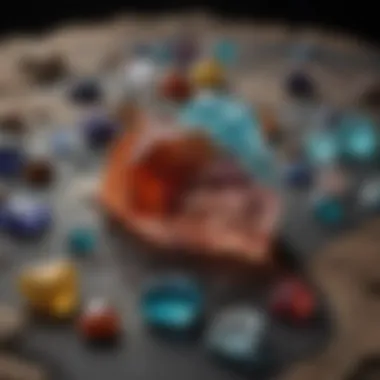
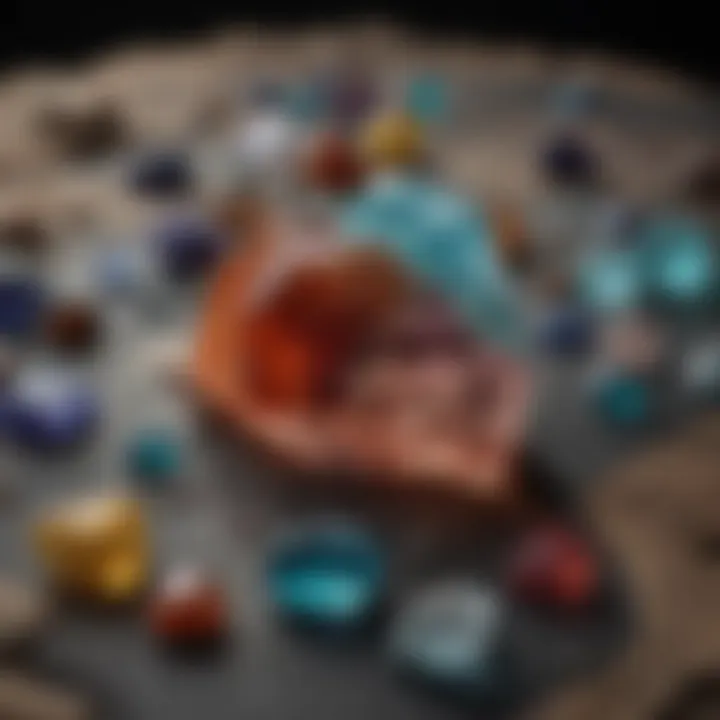
Intro
The allure of gemstones has captivated humanity for centuries. Their vibrant colors, intricate patterns, and shimmering surfaces make them highly sought after in jewelry and decorative arts. Yet behind this beauty lies a deeper understanding rooted in the physical properties of these stones. A crucial aspect that garners attention is the hardness of minerals, as measured by the Mohs scale. This simple yet insightful method offers gem enthusiasts, collectors, and scientists a window into the world of mineralogy, allowing for informed decisions when selecting gemstones.
When we speak of gemstones, we often find ourselves navigating through a labyrinth of characteristics and classifications. Understanding where a gemstone falls on the Mohs scale can reveal a wealth of information about its durability, making it an indispensable tool in gemology. Throughout this article, we will delve into the Mohs scale's history, its scientific underpinnings, and its practical applications while also shedding light on the charming domain of gemstones themselves.
Gemstone Overview
Definition and Characteristics
Gemstones are defined as minerals or organic materials that have been cut, polished, and used for decorative purposes. They can be categorized based on their unique appeal, rarity, and ability to be fashioned into jewelry. A few key characteristics that usually set these precious materials apart are color, clarity, cut, and carat weight. However, hardness is equally significant, influencing how well a gemstone can withstand scratches and everyday wear.
The Mohs scale places ten minerals in direct relation to one another to convey a gemstone's hardness. For example, talc sits at the 'soft' end of the scale, rated at 1, while diamonds, the hardest of all gemstones, hold a rating of 10. This classification is not just academic; it has practical implications in the world of jewelry making and care.
Classification of Gemstones
Gemstones can be broadly classified into two categories: precious and semiprecious stones. Often, this distinction is steeped in historical context rather than scientific reasoning.
- Precious gemstones include diamonds, rubies, emeralds, and sapphires. These stones are generally rarer and more costly due to their durability and desirability. Their hardness ratings on the Mohs scale tend to be higher, indicating they are more resistant to wear and tear.
- Semiprecious gemstones encompass a wider variety of minerals. Examples include amethyst, aquamarine, and garnet. While these stones may not possess the same level of allure or price tag as their precious counterparts, many semiprecious stones display remarkable beauty and intricacies, often captivating collectors.
Both classifications offer a treasure trove of possibilities, showcasing the rich diversity of the mineral kingdom. Since hardness is a critical attribute, understanding where a stone lies on the Mohs scale can inform decisions when it comes to both jewelry design and daily wear.
"Understanding the hardness of gemstones is akin to knowing the rules of a game; it sets the stage for how we operate within the realm of jewelry and sculpture." - Gemologist
As we navigate through the properties of gemstones, we will further explore their physical and chemical characteristics, shedding light on how these factors interplay with hardness and appearance.
Preamble to the Mohs Scale
At first glance, the Mohs Scale might seem like just another academic tool, but delve a little deeper and it turns into a key that unlocks the world of minerals. This scale, conceived over 200 years ago, serves a dual purpose: it categorizes the hardness of minerals and provides insight into their suitability for various applications. This introductory section lays the groundwork for understanding not just what the Mohs Scale is, but why it holds such significance.
The importance of this scale can hardly be overstated. It’s not just about knowing which minerals are tough and which are fragile; it’s about understanding the relationships between materials. For enthusiasts in the realm of gemstones and geology, the Mohs Scale offers a clear benchmark against which to assess and compare a rock's durability. Imagine picking a gemstone to craft jewelry; knowing its hardness could mean the difference between a lasting treasure and a piece that quickly loses its luster.
Definition and Purpose
The Mohs Scale, formulated by German mineralogist Friedrich Mohs in 1812, is a relative scale from 1 to 10 that classifies minerals based on their ability to scratch one another. At the bottom of the scale, we have talc, rated as 1, and at the pinnacle, diamond claims a solid 10. This categorization reflects not just a hierarchical structure, but paints a lively picture of mineral properties in everyday terms.
In practical terms, the scale is used widely—from identifying minerals by scratching them against known hardness values to making informed decisions about gemstone selection in jewelry-making. It’s simple enough for an enthusiastic novice yet comprehensive enough for a seasoned gemologist.
Historical Context
Understanding the historical underpinnings of the Mohs Scale reveals a fascinating narrative. In the early 19th century, the idea of measuring mineral hardness was constrained by the technology and understanding of physics at the time. Friedrich Mohs sought to create a practical tool to compare minerals—not merely through abstract number assignments but by the relationship of their scratchability.
This approach mirrored the scientific innovations of the era, where structured classification faced off against the raw beauty and diversity of the natural world. Mohs chose ten well-known minerals, picking from soft talc to robust diamond, relying on practical, observable characteristics rather than complex calculations.
First proposed in 1812 by Friedrich Mohs, this simplicity and functionality have made it a cornerstone in mineralogy and gemology ever since.
In the centuries that followed, the Mohs Scale has undergone minor refinements yet largely remains true to its initial intent. Its influence has transcended into various fields such as metallurgy, art, and conservation, proving to be a durable concept that continues to serve as a touchstone for understanding mineral characteristics. As we explore further into the structure of the Mohs Scale, it's essential to appreciate its foundation, as it illustrates not just how minerals compare, but highlights their intrinsic value in science and daily life.
The Structure of the Mohs Scale
Understanding the structure of the Mohs Scale is akin to having a map in a vast terrain of minerals. It provides clarity on how mineral hardness is classified and how it relates to various applications. This section will shed light on the essential minerals that define the Mohs Scale and the comparison to other established hardness scales. Anchoring this exploration, we will emphasize the benefits of using the Mohs Scale, considering both its simplicity and relevance in educational and practical contexts.
The Ten Minerals of the Scale
Talc
Talc stands at the very bottom of the Mohs Scale, registering a hardness of 1. This mineral is primarily composed of magnesium, silicon, and oxygen. The key characteristic of talc is its pearly luster and softness, which makes it easy to scratch with a fingernail. For beginners in gemology, talc serves as a fundamental benchmark for understanding the concept of hardness. Its unique feature is the greasy feel it imparts, which many find quite fascinating. However, in practical terms, talc doesn’t have significant use in jewelry, limiting its appeal in that sector.
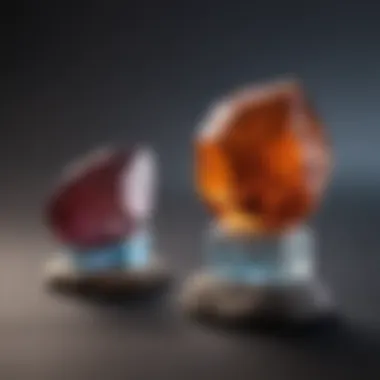
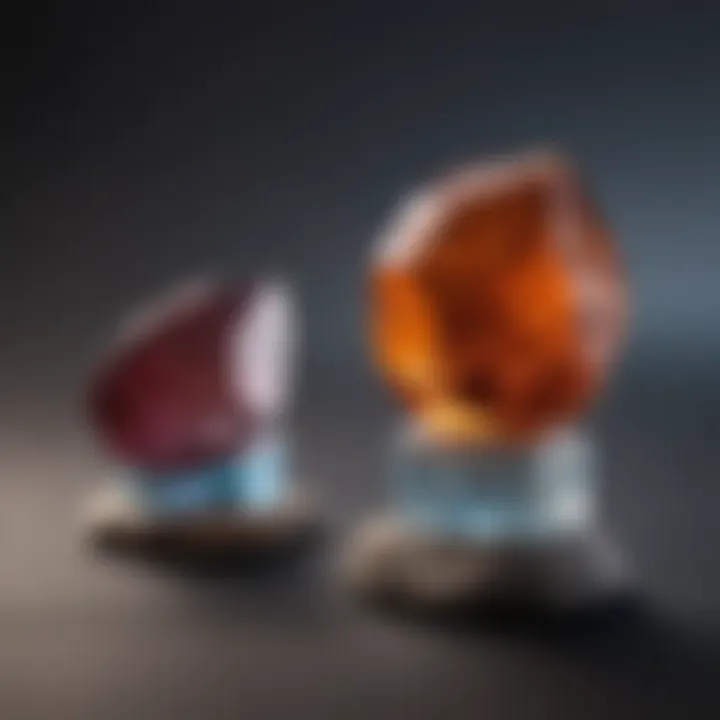
Gypsum
Gypsum is next on the scale, with a hardness rating of 2. This mineral is widely known for its use in plaster and drywall in construction. Its ease of availability and soft nature make it an excellent choice for demonstrations of mineral hardness. The key feature of gypsum is its ability to form crystals in a variety of shapes. While not commonly used in jewelry, its historical significance and purity in form offer educational value in mineralogy.
Calcite
Calcite holds a hardness of 3 and is perhaps one of the more familiar minerals in many households. Found in limestone and marble, it plays a crucial part in building materials. The pivotal characteristic of calcite is its ability to react with acids, fizzing in the presence of vinegar. This unique feature aids in both identification and educational demonstrations. In gemology, calcite serves less as a coveted stone but more as a learning tool.
Fluorite
With a hardness of 4, fluorite is popular among collectors and can come in stunning colors, making it appealing. Its crystalline form often showcases vibrant hues, from greens to purples. The key trait of fluorite is its fluorescent properties; it can glow under UV light. This characteristic, along with its relatively moderate hardness, garners attention in both the gemological community and among geological enthusiasts.
Apatite
Apatite comes in with a hardness of 5. This mineral is significant due to its presence in various forms, including the well-known gemstone variant. Key to its appeal is the range of colors, as it can be found in almost any shade from blue to yellow. However, its notable characteristic for gemologists is that while it's beautiful, it's often overlooked compared to harder stones. Apatite thus serves as a bridge between accessibility and desirability in the gemstone market.
Orthoclase
Orthoclase rates a hardness of 6 and is the mineral behind many feldspar gemstones, such as moonstone. Its key characteristic is its cleavage nature, breaking along smooth planes. This quality allows for attractive cuts that showcase its luster in jewelry. Though not as hard as other gemstones, its beauty in cutting makes it a common choice for jewelers who seek to create distinctive pieces.
Quartz
Quartz has a hardness rating of 7, placing it in a robust position. This mineral is ubiquitous, found in many varieties from clear to smoky. Quartz is celebrated for its durability in both industrial applications and jewelry. The key feature is its abundance, making it readily accessible for both collectors and manufacturers. Being tough means it can withstand everyday wear, making it a wise choice for many jewelry designs.
Topaz
Topaz sits at an 8, celebrated for its brilliance and variety of colors. Known in both aesthetic and structural contexts, topaz has become a highly sought-after gem in the jewelry world. The key characteristic is its strength and ability to be faceted into stunning designs, showcasing clear reflections and refractions. As a result, it acts as a favorable option for designer pieces, combining both beauty and resilience.
Corundum
Corundum hits a stunning 9 on the scale. This mineral is primarily known for its gemstone varieties, ruby, and sapphire, both highly revered in jewelry. The defining characteristic of corundum is its exceptional hardness among gemstones. As it's nearly as hard as diamond, its practical use in cutting tools and grinding wheels cannot be understated. Whether as gemstones or in industrial applications, corundum commands serious attention in both fields.
Diamond
Finally, we reach diamond, the champion of the Mohs Scale, with a hardness of 10. Renowned for its unmatched strength and beauty, diamonds are highly prized in the jewelry industry. The key feature of diamonds lies in their clarity and ability to refract light brilliantly, creating the coveted sparkle. Moreover, their incredible toughness makes them essential for tools beyond just adornment, impacting various industrial fields.
Comparison with Other Hardness Scales
Brinell Scale
The Brinell Scale is often used in material science and engineering, primarily to measure the hardness of metals. It incorporates a broader understanding of hardness through the use of a calibrated ball. The core advantage of the Brinell Scale is its precision for industrial materials, while its disadvantage lies in being less intuitive for the general public compared to the Mohs Scale. The Brinell method involves heavy machinery, making it less accessible for casual exploration of hardness.
Vickers Scale
The Vickers Scale also targets the hardness of materials but does so with a pyramid-shaped indenter. This methodology allows for a range of materials, from soft plastics to hard ceramics, capturing a broader spectrum of hardness values. A key benefit of the Vickers Scale is its comprehensive nature, while the complexity can be a barrier for hobbyists and enthusiasts who seek straightforward, accessible methods like those offered by the Mohs Scale.
Rockwell Scale
The Rockwell Scale is yet another means of measuring hardness, utilizing a wider range of indents. Its primary merit is speed and simplicity, often implemented in manufacturing environments. However, it may sacrifice some details in the measurement process. This contrast makes it more suited for industrial applications rather than the nuanced world of gemology, where precision and a deeper understanding are often paramount.
Applications of the Mohs Scale
The Mohs Scale serves as an essential tool across various fields, primarily where the durability of minerals and gemstones plays a critical role. This section emphasizes the importance of understanding how these applications not only inform practical choices but also foster deeper appreciation for the materials we encounter. By exploring the multifaceted uses of the Mohs Scale, we can uncover its significant impact on industries and personal choices alike.
In Gemology
Gemology is perhaps the most prominent field where the Mohs Scale shows its true worth. For gemologists, knowing a mineral's hardness can be a game changer during the identification process. When pursuing gemstones such as rubies, sapphires, or even opals, gemologists utilize this scale to evaluate their quality. That information influences their valuation and marketability. A gemstone with a higher hardness rating tends to be more resistant to scratches. This characteristic directly correlates with a stone's durability and its ability to maintain its luster over time.
In practical terms, the Mohs Scale enables gemologists to educate consumers about maintenance. For instance, softer stones like talc and gypsum require special care—owners should avoid storing them next to harder minerals like quartz or diamonds, which can scratch them easily. This protective knowledge helps gem enthusiasts choose and care for their treasures effectively.


"Hardness isn’t just a number—it’s a commitment to preserving beauty"
Industrial Uses
Beyond gemology, the Mohs Scale also finds its applications in various industrial contexts. Industries that depend on the processing of raw materials often use the scale to determine the suitable abrasives for different tasks. For instance, diamond, with a rating of 10, is the go-to mineral for cutting tools, while corundum, rated as 9, serves in grinding and polishing applications.
The significance of hardness extends to manufacturing and construction industries, where materials are selected based on their durability and wear-resistance. The scale helps in specifying materials for projects such as buildings, bridges, and other infrastructure where longevity is paramount. Furthermore, understanding the relative hardness of materials can lead to cost-effective choices, potentially minimizing maintenance costs down the line.
Consider the role of hardness in mining operations; knowing the hardness of ores can help in deciding the right equipment, reducing wear and tear, and increasing efficiency. Thus, the Mohs Scale plays an essential role that reverberates through various sectors, shaping choices and methodologies that contribute to economic viability.
Limitations of the Mohs Scale
The Mohs Scale of mineral hardness, while widely recognized and used, does have its share of limitations. Understanding these constraints is crucial for anyone delving into the field of gemology or mineralogy. The complexities of mineral identification and evaluation can often extend beyond this linear framework. As we explore these limitations, we’ll gain insights into the reasons why the Mohs Scale, despite its foundational role, is not an exhaustive measure of a mineral's physical properties.
Non-Linear Nature of Hardness
One of the most significant criticisms of the Mohs Scale is its non-linear representation of hardness. The scale ranks ten minerals based on the ability of one mineral to scratch another. However, the intervals between these ranks are not uniform. For instance, while talc ranks as a 1 and diamond a 10, the difference in hardness levels between quartz (ranked 7) and topaz (ranked 8) is not equivalent to the gap between corundum (ranked 9) and diamond. This discrepancy can lead to misunderstandings.
"While the simplicity of the scale aids in its memorability, it masks the complexities of mineral hardness."
Due to this non-linear nature, gemologists may misinterpret the hardness characteristics of minerals, especially when comparing those that fall close on the scale. A mineral ranked at a 6 may be perceived to be only slightly softer than one ranked as a 7, but in reality, the physical differences can be significant. This skewed perception might affect decision making in fields like jewelry design, where a more precise understanding of hardness could be paramount.
Bias Towards Certain Minerals
Another limitation lies in the bias towards specific minerals inherent in the Mohs Scale. The scale was originally formulated based on readily available minerals that were easily observable and representational of various degree of hardness. However, it does not include numerous other minerals that possess notable hardness yet do not fit neatly within the established ranks. For example, silicon carbide, extensively used in industrial applications for its incredible hardness, does not have a direct representation on the Mohs Scale.
This bias can lead to a narrow focus on common gemstones and minerals, making it difficult for enthusiasts or professionals to fully appreciate the diversity of materials available. In educational contexts, reliance on the Mohs Scale may inadvertently instill an incomplete understanding of the vast range of mineral properties.
Importance of Hardness in Gem Selection
When it comes to selecting gemstones, hardness plays an invaluable role. It isn't just a mere attribute but a determining factor that can significantly influence the longevity and beauty of the jewelry piece. In the world of gemology, hardness encapsulates the idea of durability. It tells collectors and jewelers a lot about how a stone will wear over time and how well it will resist scratches and other forms of damage.
Hardness as a Quality Indicator
Hardness can serve as a quality indicator for gemstones in several ways:
- Durability: Harder stones are generally more durable. For instance, diamonds, rated a ten on the Mohs Scale, stand up well to wear and tear, while softer stones like talc (rated a one) are less suitable for everyday jewelry. This aspect not only influences the purchase decision but also impacts the longevity of the piece.
- Market Value: Generally, the harder the stone, the more likely it is to command higher prices. This is because harder stones are rarer and often seen as more exquisite. Consumers often associate hardness with overall value, making it a pivotal consideration for those in the market.
- Practicality: When selecting materials for rings, bracelets, or earrings, the choice often boils down to hardness. A stone with a lower rating may just not cut it in terms of daily wear, leading to dissatisfaction down the road.
So, when jewelers or collectors assess a gemstone, evaluating its hardness is a critical component that leads to informed decision-making.
Practical Implications for Jewelers
For jewelers, the implications of hardness stretch even further:
- Design Choices: Jewelers often base their design choices on the hardness of gemstones. Certain stones may require protective settings or designs to prevent damage, affecting not just the aesthetics but also the practicality of how the piece is worn.
- Repair and Maintenance: Some stones are more challenging to repolish or repair due to their softness. Jewelers must consider the hardness of a gemstone when advising clients on care and maintenance.
- Client Education: Jewelers play an educational role, teaching clients about hardness and its implications for gemstone selection. This builds trust and understanding, allowing customers to make well-informed choices.
In summary, the importance of hardness in gem selection cannot be overstated. It affects durability, market value, and practical applications, influencing both the crafting and wearing of fine jewelry. Understanding hardness helps both collectors and jewelers navigate this complex landscape better, ensuring choices that resonate with value and functionality.
Cultural and Historical Significance of Hardness
The concept of hardness in minerals transcends its scientific definitions, reaching into the realms of culture and history. This significance manifests in various ways, reflecting how human beings have interacted with and understood these materials across time and geography. From ancient civilizations utilizing stones for tools and jewelry to modern interpretations in art and symbolism, hardness has a multifaceted role.
Consider how different cultures interpret hardness. In many societies, the strength of a material signifies durability and permanence. Diamonds, revered as symbols of love and commitment, are often associated with hardness, giving them a status that aligns with their lasting qualities. Conversely, softer minerals like gypsum have found their niche in delicate art forms, seen as beautiful precisely because of their fragility. This dualism highlights the varying perceptions of hardness throughout human history and assists in discerning cultural values associated with different minerals.
Cultural Perceptions of Hardness
Cultural attitudes towards hardness can vary immensely. In ancient Egypt, for example, stone carvings were a testament to both artistic skill and power. The Egyptians used harder stones like granite and basalt for monumental structures and statues, signifying strength, endurance, and a divine connection. The hardness of the material paralleled their beliefs in eternity, represented through their monumental architecture that still stands today.
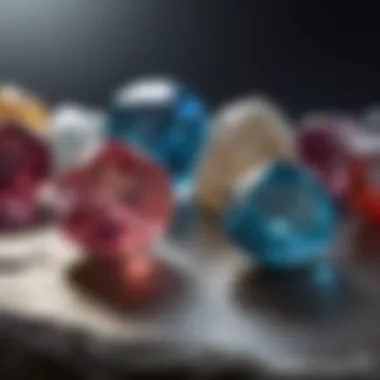
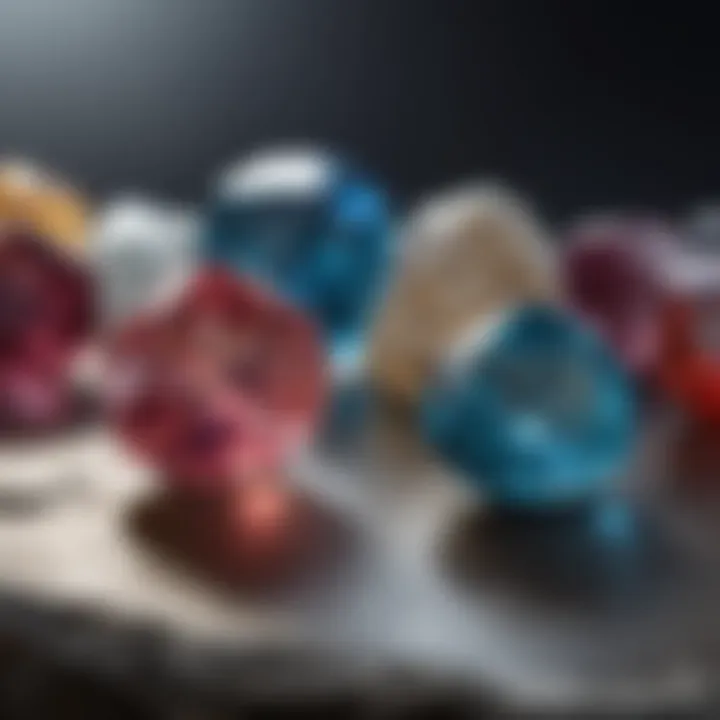
From the East, Jade has long captivated cultures in China and beyond. Valued not only for its beauty but its hardness, jadeite and nephrite symbolize purity and moral integrity. Rituals often incorporated this stone, as it was believed to protect the wearer and bring good fortune. The reverence for jade reflects a broader theme in cultures that value hardness not just as a physical property but as a catalyst for spiritual belief.
The West also takes a unique view of hardness in relation to gemstones. Sapphires and rubies are often considered precious stones not solely for their aesthetic appeal, but also for their toughness. Jewelers and collectors appreciate the hardness which allows these gemstones to withstand the test of time, further solidifying their place in romantic and cultural narratives.
In literature and art, hardness often serves as a metaphor. The phrase "tough as nails" embodies the strength and resilience associated with certain minerals, while softer elements often symbolize vulnerability. This interplay between hardness and softness enriches narratives across various forms of media, illustrating humanity’s relationship with the natural world.
Historical Uses of Hardness in Society
Throughout history, the properties of hardness have significantly influenced the practical applications of minerals:
- Toolmaking: Before the advent of modern materials, ancient humans relied on naturally hard stones. Flint was a primary material used to create tools, which were essential for survival.
- Construction: Hard stones like granite and marble have been utilized in constructing monumental buildings and sculptures, showcasing human ingenuity and the quest for immortality through stone.
- Adornment: In jewelry, the hardness of stones plays a pivotal role. For instance, emeralds are appreciated for their beauty but have a softer rating, leading to protective settings in designs.
In contemporary times, the implications of mineral hardness extend into technology and industrial applications. For instance, diamond-tipped drills and tools leverage the extreme hardness of diamonds, showcasing how ancient insights into hardness continue to inform modern innovations.
"The hardness of materials serves as a reflection of societal values, influencing both the tangible and intangible aspects of culture."
From practical uses to cultural symbols, the hardness of minerals has played a significant part in shaping human civilization. It is not merely a measure of resistance but a lens through which we can explore deeper meanings in society, art, and personal beliefs.
Educational Value of the Mohs Scale
The Mohs Scale serves not just as a benchmark for measuring mineral hardness; it is a foundational tool in the exploration of geology and gemology. The educational significance of the Mohs Scale is multifaceted, particularly for those invested in understanding mineral properties, gemstone identification, and the intrinsic characteristics that differentiate one stone from another. This scale lays a groundwork from which learners can grasp essential concepts in mineralogy while simultaneously honing practical skills that apply across various industries.
Teaching Gemology Principles
When it comes to gemology, the Mohs Scale is indispensable for teaching fundamental principles. One of the first lessons in any gemology course usually revolves around the hardness of minerals, primarily because it influences how stones should be treated, set, and worn. For instance, understanding that diamond is the hardest mineral, scoring a perfect ten on the scale, informs jewelers not only of its durability but also of its potential to scratch other gemstones.
Moreover, students learn to categorize gemstones based on their hardness, which helps in both classification and identification. By engaging with the Mohs Scale, students can practice with physical examples, scratching various stones against each other to see firsthand how hardness plays out in real-world situations. This kinesthetic learning experience enhances retention and practical application of gemology principles, making the knowledge more accessible and memorable.
In addition, the scale allows for discussions around geological processes. Students can explore how certain minerals form under varying conditions, influencing their hardness. Their understanding deepens as they relate hardness to factors such as temperature, pressure, and mineral composition.
Resources for Further Learning
To further enhance one’s knowledge of the Mohs Scale and mineral hardness, a variety of resources are readily available. These can range from textbooks to online forums.
- Textbooks to Consider:
- Online Resources:
- Mineralogy by Cornelis Klein
- Gem Identification Made Easy by Antoinette Matlins
- Wikipedia: Mohs scale provides a concise summary and history of the scale.
- Britannica's guide elaborates on its applications and implications in mineral sciences.
- Social platforms like Reddit and Facebook offer vibrant communities for sharing experiences, asking questions, and gaining insights from seasoned gemologists.
In summary, the educational value of the Mohs Scale is profound. It not only equips gemstone enthusiasts and professionals with essential skills but also encourages a deeper appreciation for the diversity and beauty of minerals. The scale serves as a stepping stone into the world of geology and gemology, guiding learners through the intricate dance of hardness, value, and aesthetic appeal in the mineral kingdom.
Future Directions in Mineral Hardness Research
As we move deeper into the realm of mineral hardness studies, the future looks bright with a blend of innovation and exploration. The prospects of advancing mineral hardness research not only enhance our understanding of various minerals but are pivotal for fields like gemology, materials science, and geology. These advancements can significantly improve gemstone selection, ensure authenticity, and further our knowledge regarding the structural properties of minerals. Here, we discuss two key areas that present substantial opportunities for growth and refinement in this domain.
Advancements in Measurement Techniques
Over the years, methods for measuring mineral hardness have evolved. While the traditional Mohs Scale remains in use, newer techniques are developing that promise to provide finer granularity in measurements. Technologies like microhardness testing and the use of atomic force microscopy allow for assessing hardness at a much smaller scale compared to earlier methods.
These advancements can lead to a better understanding of hardness-related properties without the need for subjective interpretations. For instance, nanoindentation, which applies a controlled force to a sharp indenter, provides data on hardness that is both precise and scientifically robust. This, in turn, permits researchers and gemologists to rank materials in a more layered and comprehensive manner than mere scratch tests might allow.
Researchers are also exploring how environmental conditions affect the hardness of minerals. Variations in temperature or humidity can influence the measurable hardness, and understanding these dependencies could lead to more accurate assessments across various settings. Thus, both enhanced measurement techniques and contextual awareness resonate as vital considerations for future research.
Expanding the Scale's Relevance
As we ponder the future of the Mohs Scale, the idea of expanding its relevance is crucial. The existing ten minerals serve as a foundation, yet they do not encompass the vast array of materials that may come into play, particularly with the discovery of new composites or synthetic gems. There’s a growing demand for a comprehensive approach that includes not just natural stones but also man-made minerals with unique properties.
An expansive view of hardness could incorporate minerals that exhibit hardness behaviors under specific conditions, thus offering a holistic representation. Presenting an updated scale that factors in variations could improve its use across industries ranging from jewelry-making to construction materials.
Furthermore, integrating the Mohs Scale within educational frameworks can provide students and hobbyists with practical insight. A focus on real-world applications can demystify the concept of hardness while emphasizing its significance not only in gemology but also in materials engineering.
In summary, the unfolding landscape of mineral hardness research promises to refine our understanding and application of the Mohs Scale, fostering better practices and deeper knowledge in gemology and beyond.
As we dig into the future possibilities, the interplay between old techniques and fresh ideas can pave the way for a more comprehensive understanding of mineral hardness. As advancements continue to emerge, staying informed will put gemstone enthusiasts, collectors, and researchers a step ahead.



